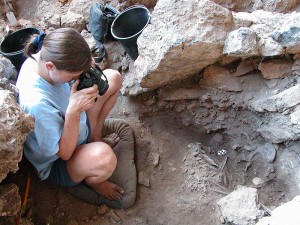
A 12,000 year-old grave unearthed in the Middle East contains the remains of a woman who provides some of the world’s earliest evidence of a religious practitioner, according to a recently published study by researchers from Israel and the University of Connecticut.
The woman was one of the Natufians, the first people to routinely bury their dead. She is one of 28 people buried in an ancient cave site in Israel, but her grave is distinct from the others: she is surrounded by 50 complete tortoise shells and select parts of a wild boar, an eagle, a cow, a leopard, and two martens – as well as a complete human foot that is not her own.
A Site Set Apart
According to the researchers, the interment rituals and the method used to construct and seal the grave suggest that it is the burial site of a shaman – one of the very earliest on archaeological record and the oldest ever found in that region.
“What sets her grave site apart from others is the multitude of animal parts placed near and around her,” says UConn archaeologist Natalie Munro, one of the authors of the paper.
“This provides strong evidence that she held a unique position in her society and is very likely an early shaman.” Munro is an associate professor of anthropology in the College of Liberal Arts and Sciences.
The cave, called Hilazon Tachtit, is located near the Sea of Galilee. The woman’s burial is unlike any other from the Natufian or preceding periods. The site is located about six miles from the nearest known settlement.
It is estimated that the woman was just under five feet tall, walked with a pronounced limp or dragged her foot, and was about 45 years old when she died around 12,000 years ago – an advanced age for the time. Her body is buried in its own separate grave within a stone structure.
Carbon dating of the site established the period when the woman lived.
The results of the research were published in the most recent edition of the journal Proceedings of the National Academy of Sciences. Leore Grosman and Anna Belfer-Cohen of the Hebrew University of Jerusalem are co-authors of the paper, along with Munro.
The grave was discovered in 2005 and the researchers conducted their work there from 2005 to 2008.
Special Care
The researchers say it would have taken a great effort to travel to the grave site with the body and assemble all the animals needed – particularly the tortoises, who would have had to be caught individually before being buried with the body.
Special care was taken to prepare the gravesite, with mud collected and plastered on the walls. Small limestone slabs were pressed into it and also lined the floor, creating a foundation.
At the time of burial, 10 large stones were placed directly on the head, pelvis, and arms of the body. The woman’s spinal column, pelvis, and right femur were placed against the curved southern wall of the oval-shaped grave, with the legs spread apart and folded inward at the knee.
“That’s a lot of effort for one woman,” says Munro. “This was no run-of-the-mill burial. It points to her respected place among her people.”
Sedentary Lifestyle
The Natufians lived in what is now Israel, Jordan, Syria, and Lebanon. They were the first society to adopt a more sedentary lifestyle with greater reliance on agriculture – representing a major change in the way people lived.
The authors write: “The unique grave at Hilazon Tachtit cave provides us with rare concrete evidence for those processes in their initial stages, at the termination of the Paleolithic on the eve of the Neolithic revolution.”
Notes Munro: “Ritual behavior coincides with the beginning of agriculture, which made groups less nomadic. These were people who were part of a more permanent community and had a good deal of contact with one another on a day-to-day basis, so it makes sense that ritualized religious behaviors also began to develop around this time.”


